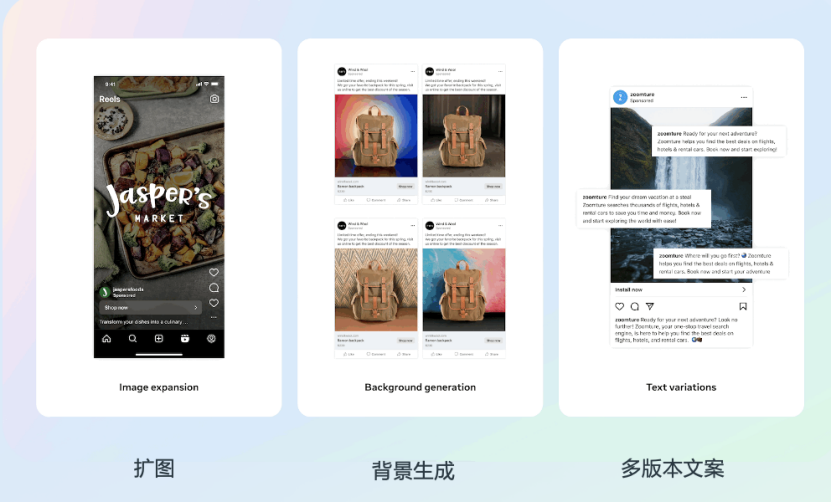AI-Driven Global Expansion: New Momentum for Chinese Brands Going Overseas
![]() 11/04 2024
11/04 2024
![]() 493
493

Editor | Liu Jingfeng
Since 2024, cross-border e-commerce has emerged as a major highlight in China's foreign trade sector.
The latest statistics from the General Administration of Customs show that China's cross-border e-commerce imports and exports reached RMB 1.22 trillion in the first half of this year, representing a year-on-year increase of 10.5%, which is 4.4 percentage points higher than the overall growth rate of China's foreign trade during the same period. Despite the huge potential and promising prospects of overseas markets, competition is fierce, and internal competition is intensifying. Merchants are also facing difficult dilemmas such as high traffic costs, difficult conversions, and low profits.
Therefore, achieving a transformation and upgrade from product exports to brand exports has become a must for an increasing number of cross-border sellers.
The surging wave of artificial intelligence has brought new development opportunities for the branding upgrade of cross-border e-commerce. More and more enterprise-level AI applications are reshaping corporate productivity with their powerful data processing, intelligent analysis, predictive capabilities, and personalized user experiences, leading to profound changes in the industry, which has entered the "AI era".
As Yin Yiding, a Cambridge scholar, stated in his book "High-Potential Brands": Chinese brands going overseas have gone through the "hardware era," "software era," and "small items era," and the next stage will usher in the 4.0 era of Chinese brands going overseas. This is the explosive growth period for Chinese brands going overseas, where traditional enterprises will fully expand overseas after completely completing their digital transformation. During this stage, the main force going overseas returns to traditional enterprises, but these enterprises have already transformed into new digital era enterprises with capabilities such as big data collection and analysis, flexible manufacturing, user-driven, precise customization, instant response, and global coverage.

Since the 1990s, China's cross-border e-commerce has gone through four stages of development.
First, the budding stage from 1998 to 2010. During this period, cross-border e-commerce initially emerged from the soil of B2B but relied on traditional foreign trade, with online information matching. After 2004, with the development of online trading platforms and payment tool innovations such as Paypal's acquisition by Ebay and the birth of Alipay, the industry developed rapidly. During this stage, cross-border e-commerce platforms evolved beyond merely showcasing product information to electronic payment, logistics, and service links.
From 2010 to 2019, China's cross-border e-commerce entered a period of rapid development. With the rapid growth of China's export trade, the cross-border e-commerce industry further expanded, attracting numerous factories and service providers. B-end buyers gradually scaled up, and C-end mobile users also experienced an explosion. Numerous B2C cross-border e-commerce companies began to emerge, such as SHEIN and Anker Innovation, marking a significant transformation period for cross-border e-commerce.
From 2020 to 2022, China's cross-border e-commerce market entered an adjustment period. Amidst global changes and the pandemic, the world economic situation and market environment were volatile, leading to industry adjustments due to factors such as overseas supply chain stagnation and rising shipping costs. During this period, the top companies diverged, and many accelerated their branding transformation.
Since 2023, the cross-border e-commerce industry has embarked on a "long-term" path of brand expansion overseas. With shipping costs returning to normal, policy support strengthening, and improvements on the supply and cost sides, leading companies have taken the lead in stabilizing and recovering. During this stage, fine-tuned and localized operations, as well as digital/information systems, have gained attention and practice, accelerating branding transformation.
From early foreign trade factories to extensive product distribution, to boutique models, and finally to today's brand cultivation period, rapid iteration of full-chain digital capabilities and product design has become the core competitiveness.
In September 2024, the international market consulting agency Kantar released the "Top 100 Chinese Brands 2024," noting that the proportion of overseas business of China's top 100 BrandZ brands has increased from 6.7% in 2020 to 13% in 2024. The agency's "Top 50 Chinese Global Brands 2024" also revealed that at least 70% of consumers are willing to consider Chinese brands, and 75% choose Chinese brands for reasons beyond price.
The DTC model is emerging as a new driving force for cross-border e-commerce brands going overseas.
The DTC model allows brands to have more control over every aspect of the process from production to sales, including pricing, marketing strategies, and customer service, enabling more flexible responses to market changes and consumer demands. By communicating directly with consumers, brands can better understand consumer needs and preferences, thereby providing more personalized products and services to enhance brand loyalty.
Since 2021, independent brand stations represented by SHEIN, PatPat, Cider, and Cupshe have successively received large financing, attracting top venture capital firms such as Vision Fund and Capital Today. According to data from Zhejiang Securities, the market size of China's cross-border e-commerce independent stations will reach RMB 3.4 trillion in 2024, accounting for 35% of the cross-border e-commerce B2C market. Independent stations have become an important base for cross-border e-commerce sellers to achieve branding development.

In the process of cross-border e-commerce branding upgrades, the importance of digitization has gradually increased.
For cross-border e-commerce platforms and sellers, it is necessary to gain deep insights into local demands and launch localized products tailored to local conditions in various aspects such as design, product selection, operations, customer service, marketing, and supply chain management. Amidst the AI boom, intelligent decision-making and marketing tools can effectively help e-commerce sellers reduce costs, increase efficiency, and reach consumers more deeply.
FUNNYFUZZY, a cutting-edge pet lifestyle brand, is a new generation of DTC brands going overseas that implements branding development strategies in all aspects under the empowerment of AI digitization. Through collaborative innovation upstream and downstream, FUNNYFUZZY creates a flexible supply chain, enabling high-standard quality control of products, which even surpasses the standards of mature European and American brands to some extent.

At the marketing level, during the initial stage of the brand, FUNNYFUZZY utilized a large number of Meta's advertising AI creative tools to produce a large amount of marketing material for promotion and trial-and-error at a low cost, efficiently identifying potential audiences. During the brand's growth stage, FUNNYFUZZY also leveraged Meta's A+SC and other AI advertising tools to save manpower and improve advertising effectiveness, achieving greater growth.
The use of generative AI in FUNNYFUZZY's daily work has reached over 35%. The application of AI technology has become the core of FUNNYFUZZY's competitiveness in the market. More precise advertising placements and in-depth market analysis brought by AI enable FUNNYFUZZY to stand out in competition.
Chen Shuo, the founder and CEO of FUNNYFUZZY, believes that AI-powered digitization + direct sales can create a more efficient retail model. For example, based on first-party data such as user purchase behavior, AI can predict the likely timing of the next purchase, thereby accurately pushing marketing information and increasing repurchase rates.
It is worth noting that Meta, as a social media platform and provider of innovative marketing solutions, has invested heavily in AI over the past few years to further improve its advertising system and help enterprises achieve better marketing results. Meta's Advantage+ product uses AI in all aspects of marketing activities, enabling full-process automation from audience targeting, bidding, creative material production, to advertising placement and optimization.
For example, the emerging jewelry brand 37Jewelry achieved a 20% increase in return on advertising spend (ROAS) and a 9% reduction in cost per acquisition (CPA) compared to traditional advertising by using Meta's advanced AI-powered shopping ads (A+SC). Moreover, compared to manual advertising, A+SC controls the fluctuations in conversion results within a relatively reasonable range, helping the brand achieve stable and continuous growth.

In October 2023, Meta introduced generative AI advertising creative functions in its advertising management tools for the first time. This function ushered in a new era of creativity, maximizing the work efficiency, personalization, and marketing performance of all advertisers. In May 2024, Meta launched enhanced generative AI functions such as full image and text generation, along with more tools and services, and integrated new generative AI functions into the Advantage+ Creative product, enabling closer integration of AI in content creativity, advertising placement, and other marketing aspects, resulting in a marketing effect where 1+1>2.
For example, during the 2023 "Cyber Week" shopping festival, the beauty and skincare brand Fresh not only used automated advertising products such as Advanced AI-Powered Shopping Ads (A+SC) and Shop Ads to optimize advertising placement and purchase paths but also delved into generative AI, leveraging Meta's text generation capabilities to produce diverse creative copy and promote sales conversions through personalized advertising messages.
This new marketing strategy and attempt brought delightful results for Fresh. The evaluation showed that from November 11 to December 2, 2023, by combining A+SC, Shop Ads, and generative AI text generation functions, Fresh's ROAS increased by 5.1 times, and purchases increased by 42%.

In his book "A Short History of Social Media," British scholar Tom Standage systematically traced the development and evolution of social media from papyrus letters thousands of years ago to the current Internet era, thereby demonstrating that social media is not a new invention of the Internet era but originated in ancient Rome over 2,000 years ago, closely related to human social nature. In the Internet era, social media has two important development trends: diversification of profit models and openness of social platforms.
Today, social media has become the first channel for some consumers to "discover" and "purchase" products, with an increasing number of people discovering and purchasing goods on social media.
Data released by Statista in July 2024 showed a significant increase in the proportion of global social commerce in retail e-commerce sales, which is expected to reach 22% by 2028. An online survey of global marketers conducted by Social Media Examiner in 2023 revealed that Facebook and Instagram have relatively fast growth rates in terms of future social media usage by global brands.
The new generation of DTC brand FUNNYFUZZY, from its inception, has leveraged Meta's vast active user base and rich ad placements and material forms on social platforms to drive traffic to its independent brand station and operate its brand, embarking on a new path from traffic business to overseas brand expansion.
When FUNNYFUZZY's official website went online in 2021, it had no traffic base as a new site. Therefore, advertising on Meta to acquire traffic was the primary means of driving traffic. FUNNYFUZZY reached people interested in its products through Meta's excellent advertising algorithms and optimized materials and pages based on detailed feedback data, continuously improving the return on ad spend (ROAS) of its products.
In the view of Chen Shuo, the founder and CEO of FUNNYFUZZY, the algorithms of e-commerce or search platforms are based on users' shopping intentions and clear demands for searching. Social platforms like Meta are discovery-oriented. When a brand has good products and creativity, it needs to expose them to more people through massive and precise exposure to increase awareness and achieve purchase conversions. At this time, Meta's advertising is the most direct and effective. These advantages enable it to help emerging brands quickly find potential users at the initial stage, verify whether products meet user demands, collect extensive user feedback on products, continuously improve products, and successfully complete the first stage of brand development.
In 2023, the FUNNYFUZZY brand gradually entered its growth stage. During this stage, the strategic core of FUNNYFUZZY was fan growth-driven. By leveraging popular products and brand communication to find loyal fans and explore more demands behind them, FUNNYFUZZY achieved continuous brand enhancement and performance growth. FUNNYFUZZY operated its accounts on social media platforms such as Instagram and Facebook with more care, systematically conducting brand communication and community building, accumulating private traffic, and enhancing brand reputation. Meta's natural social attributes and vast active user base also helped FUNNYFUZZY obtain many authentic product reviews and user feedback, some of which even turned into new design inspirations, feeding back into FUNNYFUZZY's product innovation and upgrades.
Regarding future growth, Chen Shuo stated that Meta remains a very important growth frontier. The more important growth point in the next stage is to conduct more diversified brand promotions through the fans accumulated on Meta, achieve systematic enhancement of the entire brand, further increase brand reputation, and obtain broader growth space.
Nowadays, as social media forms continue to evolve, short videos are increasingly becoming a new trend in social media marketing.
A report by the third-party research firm Wyzowl found that 91% of businesses use video as a marketing tool, and 82% of people said they decided to purchase products or services after watching brand videos. According to Deloitte Insights, approximately 70% of Generation Z prefers watching short videos over traditional TV programs and movies. This shift in consumer habits has made short videos the primary medium for attracting this demographic.
Harvard Professor Thomas Kolopoulos discussed in his book "Circle Effect" that Generation Z exhibits a clear preference for social verticalization and labeling in content consumption, favoring the use of external symbols and personality markers to identify peers, forming niche circles with strong internal cohesion.

On Meta's platform, short video content has grown rapidly, with over 3.5 billion daily shares of Reels content. By combining audio, visual effects, and storytelling, Reels can effectively evoke emotional resonance among users, achieving better marketing results. Research shows that using real-person videos on Reels can increase single-purchase costs by 11.5% and single-installation costs by 12%.
Amid the growing trend of short video marketing, cross-border sellers can leverage Reels to reach high-quality new audiences, trigger resonance, deepen connections with consumers, and drive business growth. Meta's short video social platform, Reels, is becoming a crucial frontier for brand marketing.
Conclusion:
Amid the current wave of globalization, Chinese cross-border sellers must achieve leapfrog development from Made in China to Chinese brands to stand out in the fiercely competitive international market and move towards a new stage of "high-quality going-out." As a social media platform and provider of innovative marketing solutions, Meta will continue to leverage its vast user base and advanced AI technology to empower and protect the brand building of Chinese enterprises.








